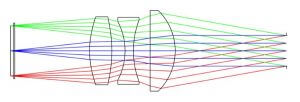10 Jan 2022
Collimating Lenses Overview
Collimating lenses are used to convert divergent light beams into parallel beams. Collimating lenses are designed for various applications covering from the UV to visible to long wave infrared range. At Shanghai Optics, we design and manufacture many different types of standard and custom collimating lenses for customers around the world. Learn more about these lenses and their uses below.

1. The figure above shows a collimating lens designed for a large light source.

2. Collimating lens converting divergent light beams into parallel beams.
What Are Collimating Lenses?
The collimating lens is typically made up of an aluminum housing with one or more lens elements and is designed to have the required focal length, diameter and mount. The main purpose of a collimating lens is to collect the light from a light source and produce parallel light beam with the required spatial resolution. A collimating lens can be attached directly to the measurement device or testing instrument. Collimating lenses can slide relative to lens fixture for adjusting the focus position.
We provide many different types of standard collimating lenses. Our standard collimating lenses including aspheric and achromatic lenses can be used for many different light sources such as highly divergent laser diodes. Our standard collimating lenses can convert divergent laser beams to well-collimated laser beams that enter beam expanders for interferometry, laser material processing and laser scanning applications. For reducing the lead time, you can build your own beam expanders to meet application requirements by selecting different sets of our standard collimating or focusing lenses. Using our standard collimating / focusing lenses, the beam expander can be designed to have magnification up to 10 times for the wavelength of 405nm, 543nm, 633nm, 780nm, 1064nm, 1310nm, 1550nm and 2000nm.
We also provide custom collimating lenses for projecting a source at infinity for infinite conjugate testing of optical systems. The collimating lenses can consist of several optical elements. The selection of optical materials and optical configuration depends on the entrance pupil diameter, wavelength, focal length, and field of view of the optical system under test.
Collimating Lens Application Uses and Benefits
With the function of collimating light beams with high accuracy and high resolution, collimating lenses are essential sub assembly of many systems for various applications including spectrometer, beam-expander system, display measuring system, laser illumination system, fiber coupler, sensor testing system, etc. Collimating lenses allow users to control for the field of view, spatial resolution and light collection efficiency of their instruments or setups.
Custom collimating lenses and beam expanders come with many benefits, including:
- Minimized energy loss or designed with high optical efficiency
- Customized coating for high-power laser applications
- High quality
- High spatial resolution
- Large field of view
- Minimized divergent angle
- Custom size and focal length
- Custom mount
How Collimating Lenses Are Produced
The typical production process for a collimating lens assembly involves manufacturing the lenses through molding or polishing, inspecting, coating, assembling and testing lenses. Though the manufacturing process will stay the same regardless of the type of collimating lens, the application of the lens may have an influence on the testing method and design details such as glass material selection and coating design. Collimating lenses can be designed and manufactured to better suit customers’ specific needs.
At Shanghai Optics, we design and manufacture custom and pre-engineered collimating lenses for meeting customers’ application requirements. For some simple projects like laser collimator and beam expander with the need of fast turnaround time, we can provide many different standard collimating lenses with different diameter, focal length, coating and mounting size. For the collimating lenses, we offer different coating options including the coating for the wavelength of 405 nm, 543 nm, 633 nm, 780 nm, 1064 nm, 1310 nm, 1550 nm, 2000 nm, etc.
If you’re looking for a more specific solution, we can also help you with custom collimating lens design and consulting. Please contact S.O. sales team for additional information.
Many customers need to use collimating lenses when solving a variety of engineering or research challenges. If you need custom collimating lenses, Shanghai Optics can help. We have more than 55 years of experience in providing high-quality custom optical lenses for industry and science research use around the world. As a high-quality collimating lens manufacturer, we produce optical products by following strict ISO 9001 guidelines and testing all our lenses with state-of-the-art metrology equipment. Request a quote online and contact one of our friendly representatives today to learn more about the short lead time, high-quality results S.O. can deliver for your next collimating lens project.
|